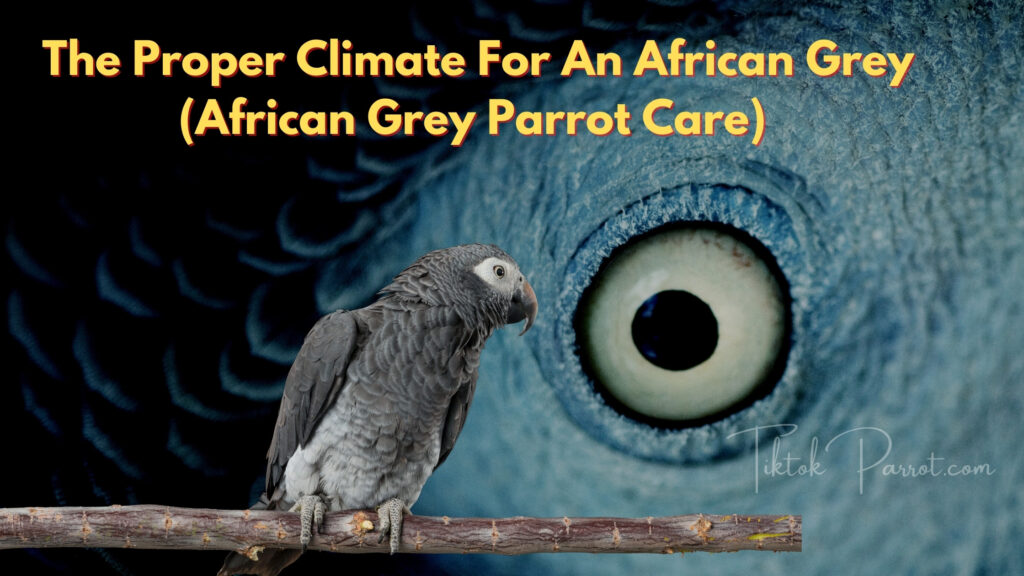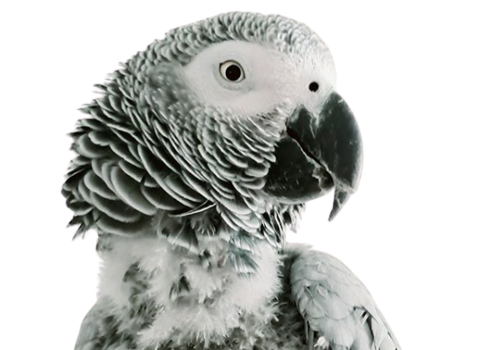Birds are animals that need a specific climate for their survival. They can’t live in the same climate as humans. In this blog, we will specifically discuss the right climate which is good for your African Grey Parrot and I would also answer some of the most common questions asked by people on my Mitthu Tiktok Parrot Social media accounts.

African grey parrots are native to the rainforests of West and Central Africa. In their natural habitat, they are used to a climate that is hot and humid, with temperatures ranging from 70 to 100 degrees Fahrenheit and high levels of rainfall.
The Right Temperature for African Grey Parrot
To provide the best climate for an African grey parrot, it is important to recreate these conditions as closely as possible. Here are some key considerations for creating a good climate for an African grey parrot:
Temperature: African grey parrots need a consistent temperature of around 70 to 80 degrees Fahrenheit (21-27°C). It is important to avoid extreme fluctuations in temperature, as these can be stressful for the bird.
Humidity: They need high levels of humidity to stay healthy and comfortable. Aim for a humidity level of around 50-60%.
Ventilation: Good ventilation is important to keep the air fresh and prevent the buildup of toxins and harmful gases.
Lighting: African grey parrots need a consistent lighting schedule, with a minimum of 12 hours of light per day. It is also important to provide plenty of natural light, as this can help regulate the bird’s sleep cycle and maintain its overall health.
Darkness: They need darkening hours as well, especially at night. Do not keep the bird in for 24 hours in light, it will not be able to sleep properly which will cause health issues. I would say at night keep the bird somewhere it’s dark or turn off the light in the area where you keep the bird.
Remember, African greys need 10-12 hours of sleep each night to stay healthy and happy.
I have received a lot of emails and messages on my Mitthu (TiktokParrot) social media accounts, below I would answer some of the most common questions asked by people from me.
Do African Greys Need Heater?
It is generally not necessary to provide a heater for an African grey parrot. African grey parrots are native to the rainforests of West and Central Africa, where temperatures are typically warm and humid. As long as the temperature in the room where the bird is kept is consistently between 70 and 80 degrees Fahrenheit, a heater should not be needed.
However, if you live in an area with extreme temperatures or if the room where the bird is kept is not well-insulated, you may need to provide a heater to ensure that the temperature stays within the appropriate range. In these cases, it is important to use a safe, bird-friendly heater that is specifically designed for use with pets.
It is also important to monitor the temperature regularly and adjust the heater as needed to maintain a consistent and comfortable climate for the bird. As with any heating appliance, it is important to follow all safety guidelines and never leave the heater unattended.
Can You Keep African Grey Parrots Outside?
It is generally not recommended to keep African grey parrots outside as a permanent living arrangement. African grey parrots are native to the rainforests of West and Central Africa, where they are used to a warm, humid climate. To provide the best care for an African grey parrot, it is important to recreate these conditions as closely as possible.
While it may be possible to keep an African grey parrot outside during the warmer months, it is important to take steps to protect the bird from extreme temperatures, wind, and other weather-related hazards. The bird should also have access to a sheltered, weather-proof area where it can retreat in case of inclement weather.
In addition, African grey parrots are social animals and need a lot of attention and interaction with their human caregivers. Keeping the bird outside may limit its opportunities for socialization and enrichment, which can have a negative impact on its overall well-being.
For these reasons, it is generally best to keep African grey parrots inside as indoor pets, where they can be provided with the appropriate climate, nutrition, and socialization.
What Temperature Is Too Hot For A Parrot?
Parrots, including African grey parrots, are sensitive to extreme temperatures and can become stressed or even suffer from heat stroke if the temperature becomes too high. The specific temperature that is too hot for a parrot will depend on the species and the individual bird, as well as the humidity and other environmental factors.
In general, parrots are most comfortable in temperatures ranging from 70 to 80 degrees Fahrenheit. It is important to avoid extreme fluctuations in temperature and to provide plenty of ventilation to keep the air fresh and cool.
If the temperature in the room where the bird is kept starts to approach or exceed 80 degrees Fahrenheit, it is important to take steps to lower the temperature. This may involve providing additional ventilation, using a fan, or moving the bird to a cooler location.
If the bird shows signs of distress or discomfort, such as panting, lethargy, or a lack of appetite, it is important to take immediate action to cool the bird down. This may involve spraying the bird with cool water or using a cool, damp cloth to wipe down its body. If the bird’s condition does not improve, it is important to seek veterinary care as soon as possible.
Can African Greys Get Too Hot?
Yes, African grey parrots can get too hot if the temperature in their environment becomes too high. Because African grey parrots are native to the rainforests of West and Central Africa, where they are used to a warm, humid climate. However, they are sensitive to extreme temperatures and can become stressed or even suffer from heat stroke if the temperature becomes too high.
The specific temperature that is too hot for an African grey parrot will depend on the individual bird, as well as the humidity and other environmental factors. As I mentioned above in general, African grey parrots are most comfortable in temperatures ranging from 70 to 80 degrees Fahrenheit. It is important to avoid extreme fluctuations in temperature and to provide plenty of ventilation to keep the air fresh and cool.
Do African Grey Parrots Feel Cold?
African grey parrots are sensitive to extreme temperatures and can feel cold if the temperature in their environment becomes too low. African grey parrots are native to the rainforests of West and Central Africa, where they are used to a warm, humid climate. As such, they are not well-adapted to cold temperatures and can become stressed or even suffer from hypothermia if the temperature becomes too low.
The specific temperature that is too cold for an African grey parrot will depend on the individual bird, as well as the humidity and other environmental factors. It is important to avoid extreme fluctuations in temperature and to provide plenty of ventilation to keep the air fresh and warm.
If the temperature in the room where the bird is kept starts to approach or falls below 70 degrees Fahrenheit, it is important to take steps to raise the temperature. This may involve providing additional heating, using a space heater, or moving the bird to a warmer location.
Should You Cover A Parrot Cage At Night?
It is generally recommended to cover a parrot cage at night to provide the bird with a sense of security and to help regulate its sleep cycle. Parrots, including African grey parrots, are social animals that need a consistent routine and a consistent environment to feel secure. Covering the cage at night can help create a sense of familiarity and predictability, which can be comforting to the bird.
In addition, covering the cage at night can help regulate the bird’s sleep cycle by creating a darker, quieter environment that is conducive to sleep. This is especially important for parrots, as they need a minimum of 10-12 hours of sleep per night to stay healthy and alert.
When covering the cage at night, it is important to use a light-blocking cover that is made of a breathable material, such as cotton or muslin. The cover should also be large enough to allow for plenty of ventilation, as parrots need a consistent flow of fresh air to stay healthy.
It is also important to make sure that the bird has plenty of room to move around and stretch its wings inside the cage, even when it is covered. Finally, it is important to monitor the bird regularly to ensure that it is comfortable and healthy while the cage is covered.
By providing the right climate and conditions, you can help ensure that your African grey parrot is healthy and happy.
If you found this blog helpful, It would be great if you could share it with your family and friends who might find it useful as well.
For more useful content about African Grey parrots, you can subscribe my site with your email to get notification upon publishing a new blog, the subscribe box you can see on the right side of this page. Also if you get an alert on your web browser while browsing my site, allow it and that will also give you an alert whenever I publish a new blog.
Stay safe and much love !



